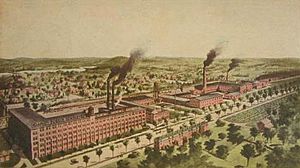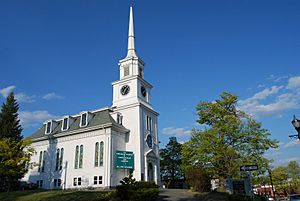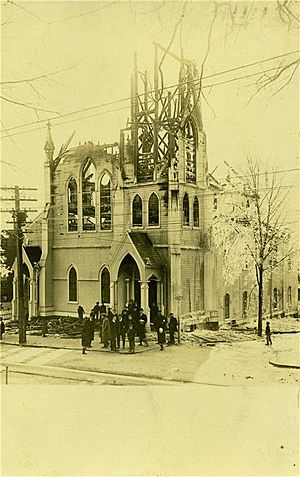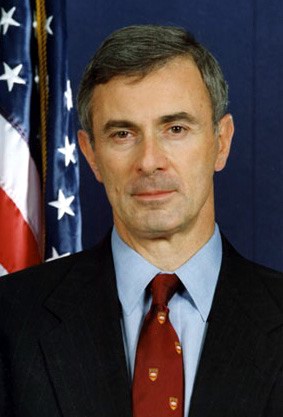Hudson, Massachusetts facts for kids
Quick facts for kids
Hudson, Massachusetts
|
||
|---|---|---|

Wood Square
|
||
|
||
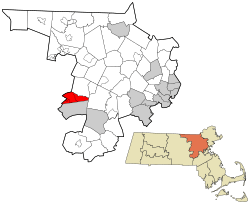
Location in Middlesex County in Massachusetts
|
||
| Country | United States | |
| State | Massachusetts | |
| County | Middlesex | |
| Settled | 1698 | |
| Incorporated | 1866 | |
| Government | ||
| • Type | Open town meeting | |
| Area | ||
| • Total | 11.8 sq mi (30.7 km2) | |
| • Land | 11.5 sq mi (29.8 km2) | |
| • Water | 0.3 sq mi (0.9 km2) | |
| Elevation | 263 ft (80 m) | |
| Population
(2020)
|
||
| • Total | 20,092 | |
| • Density | 1,747.1/sq mi (674.2/km2) | |
| Time zone | UTC−5 (Eastern) | |
| • Summer (DST) | UTC−4 (Eastern) | |
| ZIP Code |
01749
|
|
| Area code(s) | 351/978 | |
| FIPS code | 25-31540 | |
Hudson is a town in Middlesex County, Massachusetts, United States. In 2020, about 20,092 people lived there. Before 1866, Hudson was a village called Feltonville and was part of Marlborough, Massachusetts.
From around 1850 until 1968, Hudson was a mill town. It was famous for making shoes and related products. At one point, there were 17 shoe factories in town. Many of these factories used power from the Assabet River, which flows through Hudson. These factories brought many immigrants from Canada and Europe to Hudson.
Today, many residents in Hudson have Portuguese or Irish family backgrounds. Smaller groups include people of French, Italian, English, or Scotch-Irish descent. While some factories still exist, Hudson is now mostly a place where people live. The town's schools are part of the Hudson Public Schools district.
Contents
History of Hudson
In 1650, the area that is now Hudson was a special land for the Praying Indians. These Native Americans were forced to leave during King Philip's War. Most of them did not come back after the war ended.
The first European settler in the Hudson area arrived in 1699. His name was John Barnes. He built a gristmill (a mill for grinding grain) on the Assabet River. By 1701, he also had a sawmill and a bridge over the river. For the next 100 years, Hudson grew very slowly.
Hudson was once part of the town of Marlborough. It was known as Feltonville. In June 1743, people living in the Hudson area asked to become a separate town, but their request was turned down. Men from the Hudson area fought as Minutemen on April 19, 1775, during the American Revolutionary War.
In the 1850s, Feltonville got its first railroads. Hudson had two train stations, which helped factories grow. These factories were some of the first to use steam power and sewing machines. By 1860, Feltonville had 17 factories making shoes and shoe-related items. This brought many immigrants from Ireland and French Canada.
During the American Civil War, soldiers from Feltonville fought for the Union. Twenty-five of them died. Two old houses in Hudson, the Goodale Homestead (built in 1702) and the Curley home, were part of the Underground Railroad. This was a secret network that helped enslaved people escape to freedom.
In 1865, people in the Hudson area asked again for Feltonville to become a separate town. This time, their request was approved on March 19, 1866. The new town was named Hudson after Charles Hudson. He gave $500 to the town to build a library, on the condition that the town be named after him.
Over the next 20 years, Hudson continued to grow. New factories were built, including woolen mills, a factory for elastic, and a piano case factory. Banks, five schools, and the town hall (which is still used today) were also built. The town had about 5,500 residents. They lived in small houses with gardens. Hudson also had five volunteer fire companies. One of their pumps, called Eureka Hand Pump, could shoot water 229 feet!
On July 4, 1894, a big fire started by two boys playing with firecrackers. It burned down 40 buildings and 5 acres of central Hudson. No one was hurt, but the damage was huge. The town was mostly rebuilt within a year or two.
By 1900, Hudson's population reached about 7,500. The town built a power plant, so some houses got electricity. Electric trolley lines connected Hudson to nearby towns like Leominster and Marlborough. The factories kept growing, attracting immigrants from England, Germany, Portugal, Lithuania, Poland, Greece, Albania, and Italy. These new residents often lived in boarding houses near their jobs. By 1928, workers at the Firestone-Apsley Rubber Company spoke 19 different languages!
Today, many Hudson residents have Irish or Portuguese backgrounds. About one-third of Hudson residents are Portuguese or have Portuguese family roots. Most of these families came from the Azorean island of Santa Maria. The Portuguese community in Hudson has a special place called the Hudson Portuguese Club. It was started in the mid-1910s and is still active today. More recently, immigrants have come from Mexico, Central America, Brazil, and other South American and Asian countries.
Hudson's population stayed about the same until after World War II. Then, new houses were built on former farms around the town center. This caused Hudson's population to more than double. More recently, high-technology companies have built factories here, like the one Digital Equipment Corporation built (now owned by Intel). Even though Hudson now has about 20,000 people, it still uses a traditional town meeting style of government. This means citizens can vote directly on town issues.
Former Names of Hudson
Feltonville was the name of Hudson before it became a separate town in 1866. It was a village within Marlborough, Massachusetts. The name came from Silas Felton (1776-1828), who ran a store there. He was also the first postmaster in 1828. Today, you can still find the Felton name in the Silas Felton Hudson Historic District and on two streets: Felton Street and Feltonville Road.
Hudson had other names even earlier:
- From 1656 to 1700, the area was called the Indian Plantation or the Cow Commons.
- From 1700 to 1800, it was known as The Mills.
- From 1800 to 1828, the settlement was called New City.
Geography of Hudson
Hudson covers about 11.8 square miles (30.7 km²). Most of this is land (11.5 square miles or 29.8 km²), and a small part is water (0.3 square miles or 0.9 km²).
The Assabet River flows through the town. On the border with Stow is Lake Boon. This used to be a popular vacation spot, but now it's mostly a neighborhood with homes. On the border with Marlborough is Fort Meadow Reservoir. This reservoir once provided drinking water to both Hudson and Marlborough.
Towns Next to Hudson
Hudson shares borders with five other towns:
- Bolton and Stow to the north
- Marlborough to the south
- Sudbury to the east
- Berlin to the west
Villages in Hudson
The village of Gleasondale is partly in Hudson and partly in Stow.
Population and People
| Historical population | ||
|---|---|---|
| Year | Pop. | ±% |
| 1870 | 3,389 | — |
| 1880 | 3,739 | +10.3% |
| 1890 | 4,670 | +24.9% |
| 1900 | 5,454 | +16.8% |
| 1910 | 6,743 | +23.6% |
| 1920 | 7,607 | +12.8% |
| 1930 | 8,460 | +11.2% |
| 1940 | 8,042 | −4.9% |
| 1950 | 8,211 | +2.1% |
| 1960 | 9,666 | +17.7% |
| 1970 | 16,084 | +66.4% |
| 1980 | 16,408 | +2.0% |
| 1990 | 17,233 | +5.0% |
| 2000 | 18,113 | +5.1% |
| 2010 | 19,063 | +5.2% |
| 2020 | 20,092 | +5.4% |
| 2022* | 19,744 | −1.7% |
| * = population estimate. Source: United States Census records and Population Estimates Program data. | ||
In 2000, there were 18,113 people living in Hudson. About 32% of households had children under 18. The average household had 2.57 people. The median age in town was 37 years old.
By 2017, Hudson's population grew to about 19,994. Most residents were white (92.6%). Other groups included Black or African American (1.3%), Asian (2.7%), and people of two or more races (2.5%). About 6.7% of the population identified as Hispanic or Latino.
Education in Hudson
Hudson has its own public school district called Hudson Public Schools. Students who live in Hudson can attend these schools. Other students from nearby areas can also attend through a program called school choice. The leader of Hudson Public Schools is Dr. Brian Reagan.
Before starting ninth grade, Hudson students can choose to go to either Hudson High School or Assabet Valley Regional Technical High School. Assabet Valley is a technical high school open to students from several towns, including Hudson.
Schools in Hudson
- Camela A. Farley Elementary School
- Forest Avenue Elementary School
- Joseph L. Mulready Elementary School
- David J. Quinn Middle School
- Hudson High School
Private Schools in Hudson
- Saint Michael's School was a private Catholic elementary school. It served students from kindergarten to 8th grade. The school closed in 2011.
- Hudson Catholic High School (HCHS) was a private Catholic high school for grades 9-12. It opened in 1959 and closed in 2009 due to low enrollment. The building was later used by Saint Michael's School, but it has since been torn down.
According to 2017 estimates, about 90.3% of Hudson residents have graduated from high school or higher. Also, 39.8% have a bachelor's degree or higher. Most Hudson households (86.3%) had a broadband internet connection between 2013 and 2017.
Hudson Public Library
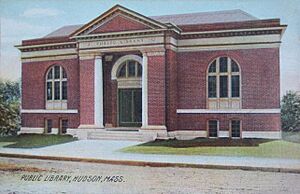
Hudson's first public library opened in 1867. Charles Hudson, who the town is named after, gave $500 to help start it. The library began as a small reading room with 721 books. In 1873, it moved to a room in the new Hudson Town Hall.
The current Hudson Public Library (HPL) building is a Carnegie library. It was built in 1905 with a $12,500 donation from Andrew Carnegie. It opened to the public on November 16, 1905. The building has a beautiful design typical of libraries from that time. In 1932, a third story was added. Today, the third floor is a quiet reading room and holds old newspapers and magazines.
In 1966, a two-story addition was built at the back of the library, making it much bigger. The children's department on the first floor was updated in 2002. The second floor is for adults and teens.
As of 2020, the Hudson Public Library has about 65,000 items. This includes books, magazines, audio recordings, videos, and historical records. The library also has three oil paintings of its main supporters: Charles Hudson, Lewis Dewart Apsley, and Andrew Carnegie. These paintings are displayed on the stairs to the third floor.
The Hudson Public Library is part of a group of libraries called CW MARS. This means that if you have a library card from Hudson, you can borrow items from other public libraries in central and western Massachusetts.
Religion in Hudson
Places of Worship
- Saint Michael's Roman Catholic Church: This church has been around since 1869. The current building was built in 1889.
- Saint Luke's Episcopal Church: This church was finished in 1913.
- First United Methodist Church of Hudson: The current Methodist Church was built in 1913 after the first one burned down in 1911.
- Unitarian Church of Marlborough and Hudson: This church is older than the town itself, built in 1861.
- Grace Baptist (Southern Baptist) Church: Grace Baptist was built in 1986 and has grown a lot since then.
- Carmel Marthoma Church: This is the newest church in Hudson, built in 2001.
- First Federated Church (Baptist/Congregational): This church was built in the 1960s.
- Seventh-day Adventist Church: This church was also built in the 1960s.
- Hudson also has a Buddhist meeting group connected with the SGI.
Churches No Longer in Use
- Christ the King Roman Catholic Church: This church joined with Saint Michael's Church in 1994.
- Union Church of All Faiths: This was possibly the smallest church in the U.S.
Media
Newspapers
- The Community Advocate
Notable People from Hudson
Many interesting people have connections to Hudson:
- Lewis Dewart Apsley: He started the Firestone-Apsley Rubber Company and was a U.S. Congressman.
- Luís Gil Bettencourt and Nuno Bettencourt: Both are famous rock guitarists. Nuno is the lead guitarist for the band Extreme.
- Matt Burke: A former defensive coordinator for the Miami Dolphins, he grew up in Hudson.
- Tina Cardinale-Beauchemin: She was the captain of the first United States women's national ice hockey team.
- Paul Cellucci: He was the Governor of Massachusetts and later the United States Ambassador to Canada.
- Shaye Cogan: A singer and film actor popular in the 1950s.
- William D. Coolidge: A physicist who invented an improved X-ray tube and the tungsten filament for light bulbs. He was elected to the National Inventors Hall of Fame.
- Hugo Ferreira: A rock musician and singer-songwriter for the band Tantric.
- Kevin Figueiredo: The drummer for the band Extreme.
- Johnny Gilroy: An All-American football halfback who played professionally in the 1920s.
- Pete Manning: A professional American and Canadian football player in the 1960s.
- Evan Markopoulos: A professional wrestler.
- Marykate O'Neil: An indie-pop singer-songwriter.
- Brigette Peterson: The mayor of Gilbert, Arizona.
- Charles Precourt: A retired U.S. astronaut.
- William B. Rice: An industrialist who co-founded a shoe manufacturing company.
- Wilbert Robinson: A famous catcher and manager for the Brooklyn Dodgers. He was inducted into the Baseball Hall of Fame. He was raised in Hudson.
- Paul Ryan: A comic artist known for Fantastic Four and The Phantom. He lived in Hudson for a long time.
- Thomas P. Salmon: He was the Governor of Vermont. He attended Hudson High School.
- William C. Sullivan: A former head of FBI intelligence operations.
- Lucy Goodale Thurston: One of the first American Protestant missionaries in Hawaii.
- Burton Kendall Wheeler: A U.S. Senator from Montana.
See also
 In Spanish: Hudson (Massachusetts) para niños
In Spanish: Hudson (Massachusetts) para niños



